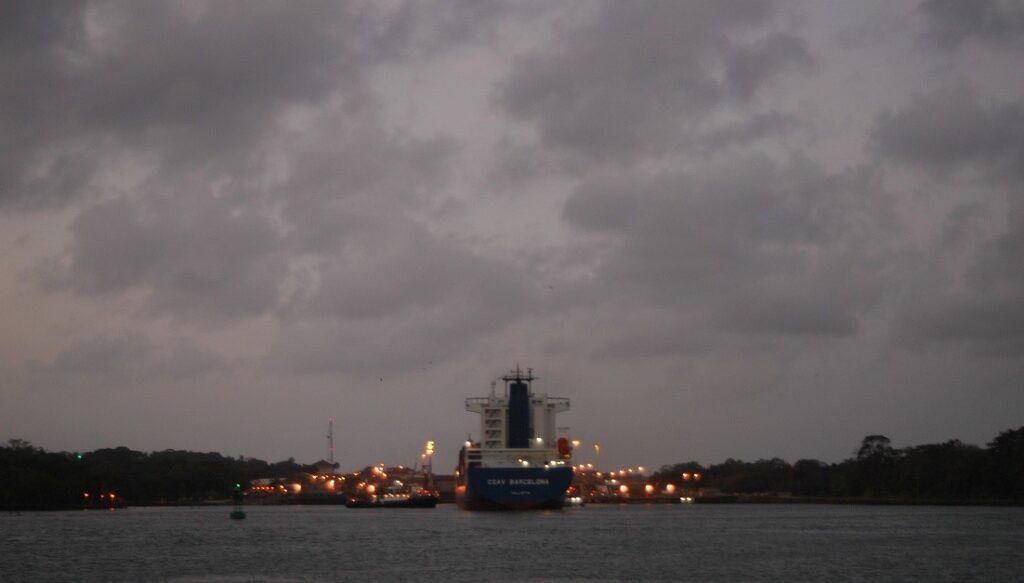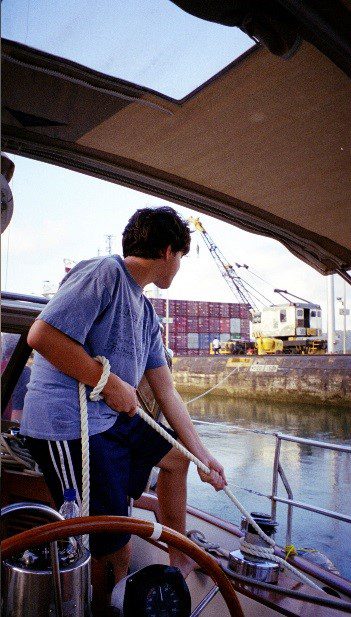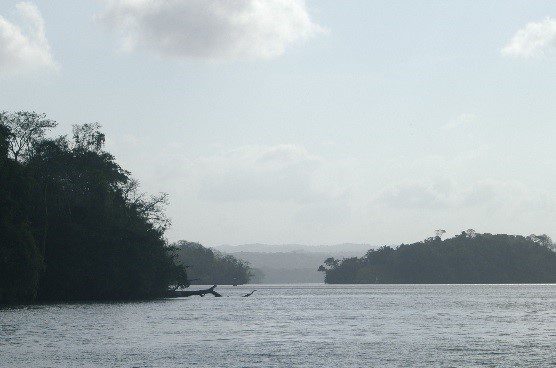Through the Canal
Thursday, 1640hrs EST, March 24, 2004:
N 04o04.249′, W 080o56.914′
(East of Malpelo Island, Pacific Ocean)
By approximately 0445 Monday morning on the day of our transit through the Panama Canal, Lillian was anchored back out in the “flats” and the Panama Canal Advisor had jumped on board from one of the threatening looking battered launch boats used to drop off pilots. By 0500 we were at full throttle in order to catch up with the tanker CSAV Barcelona, that we would follow through the Gatun Locks. Passing through the lock, we were an insignificant bit of flotsam behind that giant.



After Gatun, it took approximately three hours to motor sail across Lake Gatun, with its lush tropical vegetation. For the final two sets of locks on the far side of the lake, we rafted up with two other yachts and locked through with them. Matthew, Peter, Dick and Dracula, the cab driver/professional line handler, worked the lines that kept Lillian positioned. Everyone did a great job, and I was particularly impressed with Matthew, who handled his line like an old salt.
We got through the canal smoothly and quickly with only one eventful moment during the trip. That event occurred during our released in the Gatun lock when our autopilot “Hal” decided it was his turn to drive and autonomously engaged himself, taking control of the rudder and sending Lillian straight for the scarred cement wall of the lock chamber. Our advisor and the Canal Line Handlers looked quite stunned by the maneuver. By backing the engine, we managed to pull Lillian back with all of five feet to spare, as opposed to leaving our permanent mark on the Panama Canal. During the excitement, Peter reassured the linesmen on the wall that we had it all under control. He shouted out with such conviction and confidence that even I believed him. After the initial shock, we realized that this was not a turbulent effect caused by the strong currents in the lock, but rather Hal up to the same trick he had tried to pull back in the Manatee Pocket in Stuart Florida. With that realization, we disconnected “Hal,” much like his namesake in “2001” and he remained disconnected for the rest of the canal zone.


Due to a combination of favorable winds and lucky timing at the locks we made excellent time through the canal and by 2:30 pm we were out of the last lock and had passed under the Bridge of the Americas into the Pacific Ocean. We moored at the Balboa Yacht Club, said our final goodbye to Dracula, and “hung out” at the TGIF’s near the dock. Our agent, Tina McBride, arrived at about 6:00 pm to help process us out. We then rigged for bluewater and night operations, refueled, went over safety instructions, and then picked our way in the darkness, out through the tankers, with the Bridge of the Americas brightly lit behind us underneath the sliver of a crescent moon.
A few hours later we were clear of all lights from Panama City. The phosphorescence created a glowing milky tail that wagged twenty to thirty feet behind the boat. Surrounding that tail was a coarse sheath of sparkling, gem like phosphorescence that looked like glowing rock salt or rock candy. The crests of the waves as they passed the boat would also phosphoresce, illuminating sea and sail. For someone alone at the helm, the glowing sea was nearly hallucinogenic. At one point in the night, three streaks of luminescence began to race along side the boat. I assume they were Dolphins, evident only by a white glow, looking more like wraiths than living creatures. Very eerie.
Since departing the canal, we have again made good time. We are following a route recommended in Jimmy Cornell’s book, World Cruising Routes. This route, which goes east of Malpelo Island instead of the more direct course between Panama and the Galapagos Islands, takes advantage of the southern currents near the coast and, as a result, we have gained an additional two knots to the south, in addition to our boat speed. Until this morning, the winds have also been strong and in our favor, giving us a speed of seven knots through the water, for a
combined speed of nine knots. Since this morning, however the winds have slackened and we have used our engine instead of our sails. As we approach the equator, we enter a region known at the Inter Tropical Convergence Zone (ITCZ) where winds are typically light and confused. We have enough fuel to help for quite a bit of the route so we hope to be in Galapagos by Sunday. More later.